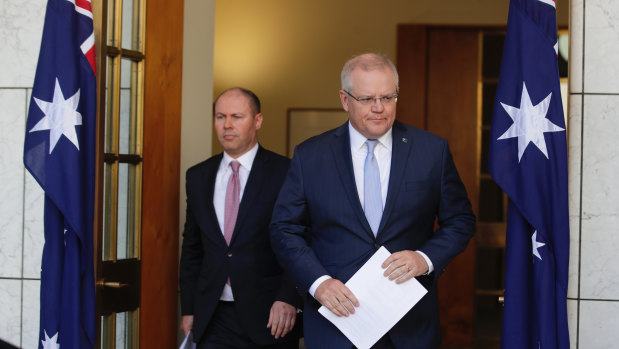This was published 5 years ago
'Tough day for Australia': Almost 600,000 people lost work in April
By Shane Wright and Max Koslowski
Australia has suffered its single largest monthly fall in the number of people holding a job, with a record 594,000 drop in the number of workers during April.
Figures released by the Australian Bureau of Statistics on Thursday showed the unemployment rate spiking a full percentage point to 6.2 per cent last month. It's the highest jobless rate since September 2015.

"This is a tough day for Australia. A very tough day," said Prime Minister Scott Morrison at a press conference in Canberra after the release of jobs figures.Credit: Alex Ellinghausen
It would have been even higher if not for the federal government's $130 billion JobKeeper wage subsidy scheme, which has officially kept many people in a job even if they are not working.
"This is a tough day for Australia. A very tough day," Prime Minister Scott Morrison said at a press conference in Canberra after the data's release.
"Almost 600,000 jobs have been lost. Every one of them devastating for those Australians, for their families, for their communities. A very tough day."
Mr Morrison said the impending economic downturn would be tougher than the global financial crisis. "This is harder - we haven't seen this before and for young people who have never experienced that, this is beyond anything they could imagine."
The participation rate, which measures the number of people in work and also those looking for it, fell 2.4 percentage points. This also helped to keep a lid on the overall jobless rate.
The number of officially unemployed people jumped by 104,500 to more than 823,300. The previous largest increase in unemployment in a single month was 65,400 in October 1982 during that year's recession. The jobless rate peaked at 10.5 per cent the following year.
It's the largest number of people out of work since September 1994. The bureau only started measuring the jobs market on a monthly basis in 1978.
A key measure of economic activity, hours worked, crashed 8 per cent through the month.
Unemployment spiked in every state and territory.
The jobless rate hit 6 per cent in NSW and Victoria, up from 4.9 per cent and 5.2 per cent respectively in March. It is now 6.8 per cent in Queensland, 7.2 per cent in South Australia, 6 per cent in Western Australia, 6.2 per cent in Tasmania, 6 per cent in the NT and 4.2 per cent in the ACT.
The number of people with a job in NSW fell by 221,400, the biggest drop in any state or territory. In Victoria, it fell by 127,100, while there were drops of 129,600 in Queensland, 62,300 in Western Australia and 40,800 in South Australia.
Participation rates also fell sharply across the states, led by a 2.8 point drop in NSW and WA.
Underemployment is now at 13.7 per cent, the highest rate on record, after jumping by 4.9 percentage points in the month.
A record 1.8 million people are now technically underemployed, with young workers the hardest hit. Underemployment among 15- to 24-year-olds increased to 23.5 per cent.
Among those aged between 25 and 34, the rate almost doubled to 14 per cent while, for people aged between 35 and 44, the rate lifted above 10 per cent for the first time on record.
Male unemployment jumped to 6.6 per cent from 5.3 per cent through the month while, for women, the jobless rate is now at 5.8 per cent. But women have borne the brunt of the increase in underemployment. Female underemployment is now at 14.8 per cent while, for men, it is 12.9 per cent.
Treasurer Josh Frydenberg said the figures revealed the "real and painful" effect of the coronavirus crisis. More than 6 million Australians were now on the JobKeeper wage subsidy and more than 1.6 million on JobSeeker unemployment benefits.
Asked whether JobKeeper would be changed in light of the latest unemployment figures, Mr Morrison said the government would stay the course.
"It's a demand-driven program," he said. "We will continue the program as we set it out."
Mr Frydenberg said the planned three-part easing of social and economic coronavirus restrictions would help get people back to work.
"Some 850,000 people will be back in work as a result of stage one, two and three restrictions being lifted," he said.